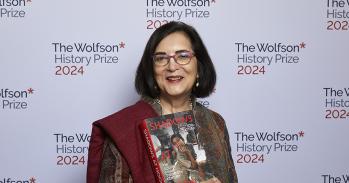
The humanities have been quick to embrace the potential of computer technology but universities have been reluctant to accept digital projects as bona fide scholarship. Katy Barrett, a PhD student at Cambridge’s Department of the History and Philosophy of Science, argues for a change in attitude.
The humanities have been quick to embrace the potential of computer technology but universities have been reluctant to accept digital projects as bona fide scholarship. Katy Barrett, a PhD student at Cambridge’s Department of the History and Philosophy of Science, argues for a change in attitude.
Why does the framework for academic excellence seem to be so far removed from the importance of public engagement and knowledge dissemination in the case of digital humanities?
Katy Barrett
Asked to picture a scientist, many of us imagine a white-coated figure in a laboratory. But how do we picture a humanities scholar? A middle-aged man sequestered in a book-lined study, at a desk piled with papers, glasses on nose, pen in hand; or possibly a pashmina-clad student in a state-of-the-art library with notepad and laptop, poring over journal articles and textbooks. Would you picture a humanities scholar working in a computer laboratory with a database or programming software? Possibly not, yet this is where you will find a ‘digital humanist’, a scholar working in an exciting and expanding area of the humanities.
The phrase ‘digital humanities’ describes the use of computer technology to process and analyse the traditional materials of humanities research. It combines humanities methodologies with computing tools to create, for example, interactive mapping programmes or computer editions of historic texts. Evolved from the software that libraries began to adopt in the 1960s to make their resources available on computers, digital humanities is gaining popularity as a scholarly activity in British universities. However, its ascendancy raises some fundamental questions about the nature of humanities research in the 21st century. Given the impact of digital media on every aspect of our lives, why is digital humanities considered a discreet discipline from the humanities as a whole?
Many of the traditional materials for humanities research can already be accessed online. Websites like JStor, the Oxford Dictionary of National Biography, Eighteenth Century Collections Online, the Old Bailey Online and Old Maps Online enable scholars to access whole libraries of material without leaving their computers. Indeed, these resources have comprehensive word-search functions that enable studies of historic documents that would have taken years in the past. For example, my own research into cultural attitudes to the longitude problem in the 18th century would be impossible without these tools, as I would not be able to find the ‘unexpected’ mentions of longitude which are, to me, gold dust.
Projects like the Newton Papers, Darwin Correspondence Project, and Casebooks Project, all currently underway at Cambridge, are digital platforms for accessing and analysing priceless archives. The Newton Papers make available online the archives of Sir Isaac Newton; the Darwin Correspondence Project does likewise for the letters of Charles Darwin. The Casebooks Project digitises early-modern medical practitioners’ notebooks of information about individual patients.
These projects protect fragile documents, while making them widely accessible at a level of detail hitherto available only from reading the documents directly; and they also open up the associated scholarship to broader audiences. Readers are able to use the platform like a scholarly edition of the works. In the case of the Newton Papers, the user is able simultaneously to view digital scans of the originals. A project currently under way at Cambridge University Library will make the Board of Longitude archives similarly available as part of the Cambridge Digital Library. This, like many digital resources, is funded by the Joint Information Systems Council (JISC). It is attached to the AHRC-funded ‘Board of Longitude’ project.
Museum collections too are embracing digital possibilities, establishing increasingly sophisticated ‘collections online’ projects. The Victoria & Albert Museum and the British Museum, for example, have now made their entire collections databases available to the public on their websites, complete with curatorial comments and bibliographic references, many with high-quality images. The virtual visitor can search and arrange the collections as they wish, save selections, download images, and leave responses.
Likewise, digital technologies are entering the museum gallery directly. UCL Museums have established the QRator project, in which visitors use iPads in the galleries to leave responses to the objects on display. Comments are then fed back directly into the interpretation on the walls, and can be accessed and continued on the related website. The European Commission has challenged British museums and galleries to make 3.9 million objects available online in the next four years. Social and digital media have revolutionised the ways in which we communicate, and in which we address issues that matter to us.
Despite the substantial time and expertise put into such digital enterprises, and despite their undoubted popularity with the public, these projects are still less likely to win academic credit for the scholars brave enough to embark on them than will a monograph with a small academic print run. Digital projects might win fans and funding, but are still under-appreciated inside the academic humanities themselves. It is difficult in many university departments, for instance, to submit a website or a database as part of a PhD thesis, and digital mapping has only recently been recognised by the Research Excellence Framework (REF) as a scholarly output of a research project. Why does the framework for academic excellence seem to be so far removed from the importance of public engagement and knowledge dissemination in the case of digital humanities?
Scholars, it seems, still have an innate distrust for ephemeral digital output, compared with the solid comfort of holding a book. Yet the struggles of digital humanities today mirror the developments in the 17th and 18th centuries that formed the backbone of the very disciplines which digital technology is now upsetting. The journal, the peer correspondence network, the carefully-constructed academic narrative to marshal sources and win supporters all overcame initial controversy to become accepted as markers of scholarly practice.
In the mid- to late-17th century, British scholars interested in natural philosophy established the Royal Society, founded on the principle that they would trust no literary authority but only the evidence of their own experiments. In practice, of course, this meant creating a network of trust and credibility for experimental results, established through correspondence and journals. This structure allowed natural philosophers to agree on codes of practice that would make experiments reliable and establish whose reports of such experiments could be trusted. Their new codes of academic practice had to work within existing traditions of gentlemanly contact and exchange.
In the early 18th century, a new ‘hot topic’ appeared to complicate this picture: the problem of how to measure longitude accurately at sea. This is what I am studying, and the parallels with current digital humanities are striking. In 1714, a new Act established a prize of £20,000 for the discovery of ‘longitude,’ attracting a flood of proposals and discussions. It was clear that improved instrumentation would be necessary to allow this problem to be solved. The instrument makers – whether skilled and established men, or hopeful first-time inventors – were outside the Royal Society scholarly codes of conduct which had begun to establish natural philosophy as a reliable discipline.
Men like Jacob Rowe and James Clarke used the explosion of new print culture to publish pamphlets advertising their schemes for solving the longitude problem. Their pamphlets sought to attract public interest as well as the notice of the experts in charge of the prize money. Such pamphlets used both text and image to persuade readers to believe in and support their ideas, and made the most of the new freedom and cheapness of print technology. The 1714 Act laid down that a successful solution to the longitude problem had to be tested at sea, but the pamphlet proposals had to succeed in this paper form before they would ever be considered worthy for trial. Such pamphlets were produced outside the carefully witnessed and corroborated world of the Royal Society, and interacted on their own terms with illustrations and sarcastic jibes at their opponents’ success. In 1715, James Clarke commented on ‘those Men’s Brains whose Heads have run so much upon Wheels ever since the Commencement of a late Act of Parliament’ (James Clarke, The mercurial chronometer improv'd, London, 1715).
Such battles over medium, reliability and scholarship in the 18th century both mirror and were the antecedents of our modern-day battles to establish the digital humanities. In both, the authority of the content is bound up with the potential fragility of the medium. The cheaply-produced pamphlet presented similar concerns over access and storage in the 18th century as the digital database does now. Digital research requires access to specialised computer technology to read and store it, and raises fresh questions about sustainably as technology changes. In the 18th century, scholars needed access to the London book trades and the money to buy pamphlets. Libraries needed rethinking to accommodate this more ephemeral output of new knowledge. These are just the kind of questions that concern traditional scholars faced with the expansion of digital tools and outputs in humanities research. But 18th-century pamphlets continue to delight and inform scholars and the public today in both paper and digital form: each raises different potentials. It is in the combination of both that the future humanities will flourish.
Katy Barrett is a PhD student on the AHRC-funded research project 'The Board of Longitude 1714-1828: Science, Innovation and Empire in the Georgian World' co-hosted by the Department of the History and Philosophy of Science at Cambridge and Royal Museums Greenwich. She is a member of the Digital Humanities for Early Career Researchers group run by CRASSH.
This work is licensed under a Creative Commons Licence. If you use this content on your site please link back to this page.





